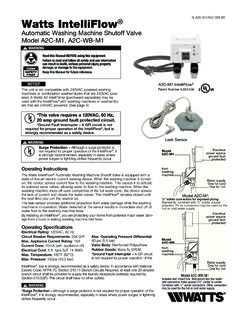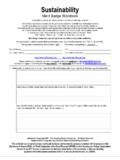Transcription of WB Holden Aircondtioning Re-Instalation
1 WB Holden Aircondtioning Re-Instalation My Ute has the rudimentary remains of the Airconditioning System in the form of the Evaporator/Heater airbox mounted forward and aft of the firewall. The original throttle suction control valve was still fitted, as was the TX Valve and the Fan speed resistance block. The former two are to be removed but the original fan speed control will be re-instated. Hence the first thing I needed to sort out was the wiring. The following diagram is allegedly from the HZ-WB manual. Note 2: There is only one connection terminal on the fan motor. The blue wire from the loom is piggy-backed to a purple wire at the connector that goes onto the fan motor terminal.
2 The purple wire then goes to terminal 86 on the relay. Typical Hella Relay The rationale behind the fan power supply is: When the Mode lever is moved from the far LH position, power is supplied to the fan switch and the Computer Switch . The source of this current is from the fuse panel on the lower dash. For speeds I, II and III the current is then routed via the Resistor panel in the side of the airbox under the bonnet to the fan motor terminal. Resistance Block For speed IIII, to make sure that the fan motor gets full voltage, the current from the switch is routed via a relay mounted on the inner guard to the fan motor terminal, which provides full battery voltage to the fan.
3 Battery voltage is supplied to this relay via a 25amp auto resetting circuit breaker on the battery side of the relay. Resetting Circuit Breaker The blower fan unit on the WB is slightly different to that on other models. Because the speed control is done with resistors and other jiggery-pokery, there is only one spade terminal for electrical connection. There is also hose from the airbox side to the commutator area to keep the brushes cool. The fan diameter is slightly larger too. Blower Fan This is the setup for delivering battery power to the fan motor on full speed. There is a pink wire from the bunch of wires from the switch which doesn t go to the resistance block on the side of the air box, but is connected to the switching side of the relay.
4 The battery power to the relay is supplied via a re-setting 25 amp circuit breaker, with the output of the relay going to the fan motor terminal. This means that there are two wires going to the fan motor terminal one from the relay for full speed, and the other from the resistance block for speeds I,II and III. Seems a bit long-winded, but works well. Front View of the Heater/ Aircondtioning control. The top, chrome lever is the fan speed control. Note that there is no Off position. This is the top view of the rear of the Heater/air conditioner control removed from the dashboard. The mid lever acts on the Master Switch, the Computer Switch and the Vacuum Selector.
5 With the lever in the far left position (viewed from the front), the Master Switch is off, and there will be no power to the Fan Speed Control or the Computer Switch (which supplies power to the Air-conditioning Compressor). Move the lever off its stop, and the Master Switch contacts, and supplies power to the Fan Speed control, and the Fan will start on whichever speed is selected. Moving the lever further to the recirculate position or next to the fresh air position will close the Computer Switch and supply power to the Airconditoner Compressor. Moving the lever further to the right to the last three positions will close the Computer Switch and deny power to the Air-conditioning Compressor.
6 This seems a bit weird, as no cool air will be available through the dash vents. Moving the Lower lever from the far left position will deny vacuum to the Heater Valve in the engine bay, which will allow the tap to open (yes open with no vacuum) and hot water to circulate through the heater core. Moving this lever further right will push the heater cable (not shown) to move the flap in the airbox to progressively allow more hot air to mix with cold air until at the full right position, full hot airflow will be allowed. In relation to airflow when the air conditioner is operating, the above settings only allow the cold air to be delivered to the floor vents.
7 I have modified the system so that the air conditioner compressor is supplied with power from a relay in the engine bay, with a positive control to the relay feed from the switched side of the Master Switch (so the compressor will only run if the fan is operating) and a negative feed from a separate switch on the instrument panel (so the air conditioning will operate regardless of which position the upper lever is in, except when it is in the far left off position) and positive from a fused line direct from the battery. The Computer Switch has been bypassed. The caution here is that the air conditioner should not be operated with full heat selected, as there will be no airflow through the air conditioner evaporator, which could freeze up.
8 There are several ways of monitoring the temperature of the evaporator to prevent it freezing up. Shown above is a Thermo Amp and Thermistor setup. The thermistor is inserted into alongside the fins to monitor the temperature of the air coming off the evaporator coil. When the temperature approaches freezing, the relay in the Thermo Amp drops out interrupting the power to the compressor clutch. When the temperature of the air rises to a pre-set level the power is returned to the compressor clutch. A Capillary tube unit will perform the same function, but measures the temperature of the fins, rather than the temperature of the air. Either replace the suction throttling valve in the original setup.
9 Cool air temperature is adjusted using a potentiometer mounted inside the cabin. For this installation, a hole was cut in the side of the evaporator casing to allow the thermistor to be located against the fins down-stream of the evaporator, and the panel through which the cable passes was screwed over the hole to make it air-tight. The Thermo Amp was mounted alongside the fan relay on the inner guard. Thermistor Wiring Sanden Compressor Showing the Sanden compressor mounted on the engine. This compressor came from an aftermarket installation on another vehicle with a similar 253 motor. The 16 thermo fan was already mounted on the after-market aluminium radiator and is operated via a temperature sensor in the head.
10 Above is an overview of the setup after commissioning. The original evaporator and blower fan unit are located on the firewall. The compressor mount is aftermarket, picking up on the water pump bolts at the front and the block and alternator pivot bolt at the rear. The receiver drier is located on the inner guard, just below the headlight relay. A Super Parallel Flow 14 x 26 condenser, was mounted in a RHS frame carrying the twin 13 thermatic fans, and was mounted in the space in front of the radiator in the Statesman nose-cone using existing brackets at the bottom of the radiator, and mounting holes on the top radiator support. The fans operate as soon as air-conditioning is selected, and continue to operate, even if the compressor cycles off due to low temperature in the cabin, or high/low refrigerant pressure.






